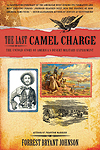 The Last Camel Charge: The Untold Story of America’s Desert Military Experiment, by Forrest Bryant Johnson, Berkley Caliber, New York, 2012, $25.95
The Last Camel Charge: The Untold Story of America’s Desert Military Experiment, by Forrest Bryant Johnson, Berkley Caliber, New York, 2012, $25.95
The Last Camel Charge relates the short, improbable history of the U.S. Camel Corps, an antebellum experiment by the Army to use heat-tolerant camels instead of pack mules or horses to supply desert outposts and lead expeditions across the American Southwest. It is not, as the subtitle suggests, an Untold Story. The December 2007 issue of Wild West featured an article by Paul Andrew Hutton about the Camel Corps, and the corps features in at least a half-dozen books. But it is a story well worth the retelling, taking in a broad sweep of the frontier West and starring a cast of such American notables as Zachary Taylor, Jefferson Davis, Kit Carson and Brigham Young. Author Forrest Johnson, a nine-year veteran of the Army and 30-year resident of the Southwest, brings those experiences to bear in his account of the Army’s Southwest camel trials.
The story has its genesis in 1836 during the Second Seminole War, when Army quartermaster George Hampden Crosman, citing the 2,000-year track record of the camel as a pack animal in North Africa and Asia, floated the idea of its use in the oppressive Florida heat. In 1846, as the Mexican War rolled around, then-Major Crosman pointed to the desert expanses of that country and repeated his camel pitch. After the war he and fellow officers lobbied senators on the subject. Among those senators was fellow Mexican War veteran Jefferson Davis of Mississippi, chairman of the Senate Committee on Military Affairs. After Davis was appointed secretary of war in 1853, he repeatedly pressed Congress for the funds to import and test camels. Davis pointed not only to the ongoing “Indian problem” in the desert Southwest, but also to the rising power of the Mormons under Brigham Young in Utah Territory. His pitch worked, and in 1855 Congress granted Davis $30,000 “to be expended under the direction of the War Department in the purchase and importation of camels and dromedaries…for military purposes.”
Johnson recounts the long and often-frustrating 1855 mission to acquire the first batch of camels from Tunis, Turkey and Egypt, including a near diplomatic row in the latter country. A year later the camels landed at the port of Indianola, Texas, where locals ridiculed the ungainly beasts until handlers loaded up one large male with 1,300 pounds of hay, commanded the animal to stand, which it did effortlessly, and then led it around the dock to the onlookers’ cheers and applause.
The camels’ first practical test came in 1857–58 on a yearlong, 4,000-mile round-trip expedition to forge a wagon road from New Mexico Territory to California. The “noble beasts” performed as advertised and impressed officers with their uncanny knack for finding water sources and ability to forge rivers with ease. Other expeditions followed, one to conduct a topographical survey of Texas’ Big Bend country, another to improve the wagon road. The camels also proved their worthiness under fire during a desperate charge through an overwhelming force of Mojave Indians at a disputed Colorado River crossing—with not a camel or a rider lost to the enemy.
Then came the Civil War, and strangely the Army leadership forgot the camels, now split between California and Texas. Sold at auction, the California herd was parceled out to ranchers and various hauling operations. The 80-strong Texas herd, meanwhile, fell into Confederate hands. Some ended up on the front lines, one named “Old Douglas” falling victim to a Union sniper during the 1863 siege of Vicksburg. Still others wandered off into the desert. Camel sightings persisted for decades in the Southwest, the last known survivor being Topsy, a captive camel that died in 1934 at Los Angeles’ Griffith Park Zoo.
Johnson entertains and informs throughout, weaving in interesting facts and anecdotes amid the somewhat complicated narrative. One compelling chapter titled “What Is a Camel?” shares such surprising facts as the North American origin of these animals, their unmatched speed (45 mph in short bursts, and 25 mph over a full hour) and their preference for prickly desert foliage over grass. Johnson also describes the camel’s literal Achilles’ heel—padded feet that support the animal wonderfully on soft sand but are especially vulnerable to the stony landscapes prevalent in the Southwest. But a stone didn’t bring down this Goliath. It was bureaucracy killed the beast.
—Dave Lauterborn




